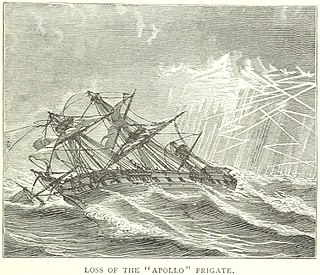HMS Thunderer was a ship of the line of the Royal Navy, built in 1783. She carried 74-guns, being classified as a third rate. During her service she took part in several prominent naval battles of the French Revolutionary Wars and the Napoleonic Wars; including the Glorious First of June, the Battle of Cape Finisterre and the Battle of Trafalgar.

HMS Apollo, the fourth ship of the Royal Navy to be named for the Greek god Apollo, was a fifth-rate frigate of a nominal 36 guns. She was the name ship of the Apollo-class frigates. Apollo was launched in 1799, and wrecked with heavy loss of life in 1804.

HMS Hydra launched in 1797 was a fifth-rate frigate of the Royal Navy. From 1813 to 1817 she served as a troopship. She was sold in 1820.

Pomone was a 40-gun frigate of the French Navy, launched in 1785. The British captured her off the Île de Batz in April 1794 and incorporated her into the Royal Navy. Pomone subsequently had a relatively brief but active career in the British Navy off the Atlantic and Mediterranean coasts of France before suffering sufficient damage from hitting a rock to warrant being taken out of service and then broken up in 1803.
His Majesty's Hired armed cutter Lurcher was a 12-gun cutter that served the Royal Navy from 15 August 1795 until 15 January 1801 when a French privateer captured her in the Channel.
HMS Firm was a 12-gun Archer-class gun-brig of the Royal Navy, launched on 2 July 1804. She served in the Channel, where she engaged in one action that would eventually result in her crew qualifying for the Naval General Service Medal. She grounded in 1811 and her crew had to destroy her before abandoning her.
HMS Garland was the French privateer Mars, launched in 1798 that Amethyst captured in 1800. The Royal Navy took her into service and sent her out to the Jamaica Station. There she had a brief, eventful career before she was wrecked in 1803.
Mutin was a 14-gun cutter of the French Navy, the lead ship of the Mutin class of five naval cutters. She was launched in 1778 and the Royal Navy captured her the next year, taking her into service as HMS Mutine. The Royal Navy renamed her HMS Pigmy in 1798. She was lost in 1805.
HMS Hawk was an 18-gun sloop-of-war, previously the French privateer Atalante, that HMS Plantagenet captured in 1803. The Royal Navy took Atalante into service as HMS Hawk; she foundered in 1804.

Robert was a 16-gun French privateer corvette launched in 1793 at Nantes. The British captured her in 1793 and named her HMS Espion. The French recaptured her in 1794 and took her into service as Espion. The British recaptured her in 1795, but there being another Espion in service by then, the British renamed their capture HMS Spy. She served under that name until the Navy sold her in 1801. Spy then became a slave ship in the triangular trade in enslaved people, a merchantman to South America, and privateer again. The French captured her in mid-1805 and sent her into Guadeloupe.
His Majesty's Hired armed cutter Sandwich served the Royal Navy from 23 May 1798 until the French frigate Créole captured her on 14 June 1799. She then served in the French Navy until the Royal Navy recaptured her on 15 October 1803. The Navy purchased her in 1804 and she served for some months in 1805 as HMS Sandwich before she was sold in Jamaica. During this period she captured three small French privateers in two days.
HMS Speedwell was a mercantile vessel that the Admiralty purchased in 1780. During the American Revolutionary War she served at Gibraltar during the Great Siege. In 1796 she was converted to a brig. Although she did capture two French privateers and participate in an incident in which the Royal Navy violated Swedish neutrality, her service in the French Revolutionary and Napoleonic Wars was apparently relatively uneventful. A storm in February 1807 destroyed her, causing the loss of her entire crew.
His Majesty's hired armed cutter Duke of Clarence, named for William Henry, Duke of Clarence, served the British Royal Navy under two contracts, one during the French Revolutionary Wars, and one at the beginning of the Napoleonic Wars. She was lost on 25 November 1804, but without loss of life.
During the period of the Napoleonic Wars, the British Royal Navy twice employed a vessel named His Majesty's hired armed cutter Albion, though these are probably the same vessel:
HMS Busy was launched in 1797 as the only member of her class of brig-sloops. She captured one French privateer and numerous small merchantmen, but spent most of her career escorting convoys to and from the West Indies. She foundered in 1807 while serving on the Halifax, Nova Scotia, station.
HMS Morne Fortunee was originally the Bermudian schooner Glory, launched in 1801 but captured in 1803 as the French privateer Morne Fortunée. She was wrecked in 1804.

HMS Monkey was launched in 1801 at Rochester. She served in the Channel, North Sea, and the Baltic, and was wrecked in December 1810.
HMS Redbridge was the French privateer cutter Oiseau, which had been commissioned at Rochefort in August 1803. HMS Argo captured her in September 1803. The Royal Navy took her into service as HMS Redbridge. She foundered at Jamaica in February 1805.
Between 1793 and 1805, five cutters served the British Royal Navy as hired armed vessels under the designation HM hired cutter Rose:
HMS Barbadoes was originally a French privateer and then slave ship named Brave or Braave. A British slave ship captured her in September 1803. In 1803–1804 she became the British privateer Barbadoes for a few months. In 1804 the inhabitants of Barbados purchased her and donated her to the Royal Navy, which took her into service as HMS Barbadoes. She wrecked on 27 September 1812.




